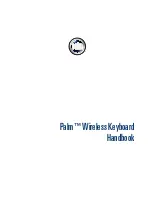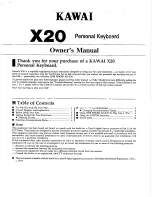
Voice Mode
MOTIF-RACK XS Owner’s Manual
81
Basic Structure
V
oice
Multi
Utility
Ref
erence
The Contr
ols &
Connector
s
Setting Up
Listening to
the Sound
Connections
Using a Computer
Quic
k Guide
Appendix
Time Key Follow
(EG Time Key Follow Sensitivity)
Determines the degree to which the notes (specifically, their position or octave range) affect the
Amplitude EG times of the selected Element. When this is set to a positive value, high notes result in
a fast Amplitude EG transition speed while low notes result in a slow speed. When this is set to a
negative value, the opposite effect is produced: High notes result in a slow Amplitude EG transition
speed while low notes result in a fast speed. When this is set to 0, the Amplitude EG transition speed
does not change no matter what the pressed note.
Settings:
-64 – +0 – +64
AMP Scale (Amplitude Scale)
Break Point 1 – 4
Determines the four Break Points by specifying the respective note numbers.
Settings:
C -2 – G8
n
Break Point 1 to Break Point 4 will be automatically be arranged in ascending order across the keyboard.
Level Offset 1 – 4
Determines the offset value to the level at each Break Point. For details about Amplitude Scaling,
refer to “Setting example of Amplitude Scaling” (page 90) in the Supplementary information.
Settings:
-128 – +0 – +127
LFO (Low Frequency Oscillator)
LFO Wave
Selects the Wave and determines how the LFO waveform modulates the sound.
Settings:
saw, triangle, square
Speed
Determines the speed of the LFO Wave.
Settings:
0 – 63
Key on Reset
When this is set to on, the LFO waveform is reset every time a Note On message is received.
Settings:
off, on
off ...................................... The LFO cycles freely with no key synchronization. Receiving a Note On message starts the
LFO wave at whatever phase the LFO happens to be at that point.
on ...................................... The LFO resets with each received note and starts a waveform at the phase specified by the
Phase parameter (page 69).
Delay
Determines the delay time between the moment a Note On message is received to the moment the
LFO comes into effect. A higher value results in a longer delay time.
Settings:
0 – 127
Fade in Time
Determines the amount of time for the LFO effect to fade in after the Delay time has elapsed. A
higher value results in a slower fade-in. When set to “0,” the LFO effect will not fade in and reach the
maximum level immediately after the Delay time has elapsed.
Settings:
0 – 127
P Mod
(Pitch Modulation)
Determines the amount (depth) by which the LFO wave varies (modulates) the pitch of the sound.
The higher the setting, the greater the depth of control.
Settings:
0 – 127
F Mod
(Filter Modulation)
Determines the amount (depth) by which the LFO wave varies (modulates) the Filter Cutoff
frequency. The higher the setting, the greater the depth of control.
Settings:
0 – 127
A Mod
(Amplitude Modulation)
Determines the amount (depth) by which the LFO wave varies (modulates) the amplitude or volume
of the sound. The larger the setting, the greater the depth of control.
Settings:
0 – 127
EQ
Type
(EQ Type)
Determines the EQ Type. The number of parameters and values available differs depending on the
selected EQ type.
Settings:
2 Band (2 Band EQ), P.EQ (Parametric EQ), Boost 6 (Boost +6dB), Boost 12 (Boost +12dB), Boost18 (Boost
+18dB), thru
2 Band............................... This is a “shelving” equalizer, which combines separate high and low frequency bands.
P.EQ................................... The Parametric EQ for the single band is used to attenuate or boost signal levels (gain) around
the Low Freq according to the settings of Low Gain. Determines the bandwidth with which the
sound will be boosted or cut in the “Q” parameter.
Boost 6, Boost 12, Boost18
.......................................... Boosts the entire band of the selected Element by +6dB, +12dB, and +18dB respectively.
These settings have no adjustable parameters.
thru .................................... If you select this, the equalizers are bypassed and the entire signal is unaffected.
Low Freq
This parameter is available only when the Type (EQ Type) parameter is set to “2 Band” or “P.EQ.”
When setting to “2 Band,” this determines the center frequency of the lower EQ band. When setting
to “P.EQ,” this determines the center frequency.
Settings:
When the Type is set to “2 Band”... 50.1Hz – 2.00kHz, When the Type is set to “P.EQ”... 139.7Hz – 12.9kHz
High Freq
This parameter is available only when the Type (EQ Type) parameter is set to “2 Band.” This
determines the center frequency of the high EQ band.
Settings:
503.8Hz – 10.1kHz
















































